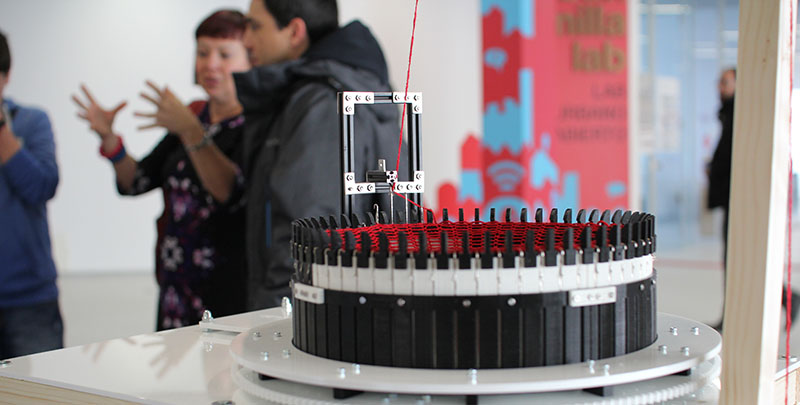There have been a few posts on Hackaday over the years involving knitting, either by modifying an old Brother knitting machine to incorporate modern hardware, or by building a 3D printed knitting machine. All of these hacks are examples of flat knitting, and are incapable of making a seamless tube. Circular Knitic bucks that trend by using 3D printing and laser cutters to create an open source circular knitting machine.
Circular Knitic is an expansion on an earlier build that gave a new brain to old Brother knitting machines from the 70s. This build goes well beyond simple manipulation of electrons and presents an entire knitting machine specifically designed for circular knitting. It’s completely automated, so once the machine is set up, a giant tube of knit yarn is automagically created without any human intervention.
This isn’t the first completely open source knitting machine; OpenKnit can be made with aluminum extrusion, some electronics, and a few 3D printed parts. Circular Knitic is, however, the first circular knitting machine we’ve seen, and according to the Github is completely open source.
The creators of Circular Knitic, [Varvara] and [Mar] have been showing off their machine at an exhibition in Zaragoza, Spain called DOERS, where they’ll be knitting for the better part of six months. You can see some video of that below.
















Nice machine. I’m curious for what speed its able to reach, at the end of the second video the knitting machine turn slower than knitting by hand. Also there only seems to be one (automated) pattern possible. Programmable patterns will be possible when every needle is individually controllable.
I’ve seen round knitting machines before. A small one with 22 needles and hand crank is fairly in expensive, about $80,-. Complex machines with programmable patterns and multiple threads are too expensive for the hobby market.
I’m a bit disappointed because I made the assumption that Arduino equals CNC pattern control. While I want to snark about an Arduino + stepper driver + NEMA23 stepper being used where a DC motor could, I’d like to believe that it’s there for future support for steppers or solenoids to control the needle lift and select different yarns.
Reblogged this on Übermüdet Mirror and commented:
Eigentlich was für 3dDinge – 3dgedruckte Rund Strickmaschine, genial!
“All of these hacks are examples of flat knitting, and are incapable of making a seamless tube.” WRONG http://hackaday.com/2014/01/27/agnes-roboknit-a-robot-so-creepy-it-even-has-a-facebook-profile/
Not even true for a double bedded flat bed machines on which I make tubes all the time. The AYAB hack works on double bedded (i.e. machines with ribbers).
https://bitbucket.org/chris007de/ayab-apparat/wiki/english/Home
Tube tops for everyone!! Ok, so what is the advantage of being able to knit as tube?
I guess it makes it easy to make socks?
My grandmother was a seamstress and she had one of these. Made a lot of scarves and hats. Hers was very old and extremely fast. It could be programmed to select between four different spools of yarn on the fly.
At the end of the video, It was going so slowly that I was wondering if it wasn’t intentional, with the idea of indicating the passing time or something like that. But it doesn’t seem to be the case. But now imagine a knitting machine, fixed on the wall, that knits a scarf per day, veeeeeery slowly, and indicates the time with numbers inserted in the partern in an other color, that would be fun :-D
http://odditymall.com/scarf-knitting-clock
hahaha :-D Nice ! Thanks for sharing !
I must say, once a year that’s way more reasonable than once a day !
I have no idea how complicated it would be to use two colors to knit a usable calendar … I have to check how these machines work :-)
Here’s a circular knitting machine made of Lego: https://www.youtube.com/watch?v=MV19wqtfyF0